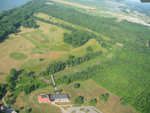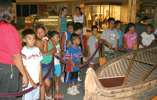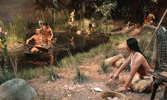That hand is not the color of yours, but if I pierce it, I shall feel pain. The blood that will flow from mine will be the same color as yours. I am a man. The same God made us both.”
Those are the words of Ponca Chief Standing Bear during his groundbreaking trial in 1879 when he was arrested for returning to his native Nebraska home after being forcibly moved, along with the rest of the Ponca tribe, to Oklahoma. The judge in the trial ruled that “an Indian is a person within the meaning of the law,” giving Native people the right to go where they wanted and to leave the confines of their reservations.
To this day, Standing Bear is remembered as one of this country’s first civil rights activists.
Bank groups can learn more about this Native American hero at a museum that bears his name in Ponca City, Oklahoma. More poignant stories are told at Native American parks and museums throughout the country, venues that tell us history we probably never learned and surely could not appreciate in a classroom.
Wheelwright Museum of the American Indian
Santa Fe, New Mexico
Founded in 1937, the Wheelwright Museum of the American Indian is the oldest nonprofit museum in New Mexico. The museum hosts changing exhibits of Native American art with an emphasis on the Southwest. Small galleries host one-person shows by Native American artists and photographers.
Through April 2010, the museum is hosting Through Their Eyes: Paintings From the Santa Fe Indian School. “This exhibit features paintings created by students who attended the Santa Fe Indian School between 1918 and 1945, including well-known artists like Fred Kabotie and Velino Shije Herrera,” said Diana Ceres, marketing and public relations coordinator.
Groups will want to take advantage of Looking at Indian Art, a Saturday discussion group where groups are versed on a variety of topics, including jewelry, pottery, Navajo rugs, baskets, folk art and more, by a museum expert.
They will also want to spend time in the museum’s gift shop, the Case Trading Post, the oldest Native American gallery in Santa Fe.
 |
| The Angel Mounds State Historic Site near Evansville, Indiana, is considered one of the best-preserved prehistoric Native American sites in the United States. Courtesy Friends of Angel Mounds |
“The Case Trading Post offers high-end treasures, from textiles to pottery to jewelry, and groups get 10 percent off,” said Ceres.
(800) 607-4636
www.wheelwright.org
Angel Mounds State Historic Site
Evansville, Indiana
More than 1,500 Native American people lived on the Angel Mounds village site from A.D 1100 to 1450. “We call them the Mississippians, and you could find this culture up and down the Mississippi Valley,” said Mike Linderman, property manager. “Our site is nationally recognized as one the best-preserved prehistoric Native American sites in the United States. There are no subdivisions or highways in sight.”
The site includes 11 mounds. “Ours are not burial locations, they are more like status mounds. As a Mississippian, the higher your mound, the higher your status was. The highest mound is where a chief would have lived.
“And, unlike nomadic cultures, these people lived here year round, and the site includes permanent mud residences with thatched roofs. I tell the kids that these are the mansions of their times,” said Linderman.
Angel Mounds hosts several annual events, among them educational archaeological discussions, native gardening workshops and a fine-arts bazaar. A large interpretive center has exhibits, artifacts and art.
(812) 853-3956
www.angelmounds.org
Akta Lakota Museum and Cultural Center
Chamberlain, South Dakota
Constructed in 1968 on the banks of the Missouri River, the 14,000-square-foot Akta Lakota Museum and Cultural Center once served as the St. Joseph’s Indian School. Today, this distinctive, circle-shaped building displays the history of the Lakota people.
The museum, whose outside walls depict 10 Lakota and Dakota chiefs, holds a collection of art by Lakota, Dakota and Nakota artists, as well as cultural displays. These Native Americans were all part of the Sioux Tribal Nation.
 |
| The Akta Lakota Museum and Cutural Center near Chamberlain, South Dakota, has cultural displays and art by Lakota, Dakota and Nakota artists. Courtesy Akta Lakota Museum and Cultural Center |
“Because of the circular shape, we are able to feature a pictorial diorama that shows the Lakota life throughout history. It begins with a Native American scraping a buffalo hide and continues through with the arrival of white people; the Lewis and Clark expedition; the trading years, when they first started using beads; the Indian wars; and ending with contemporary art,” said Jona Ohm, marketing representative.
The museum also includes a variety of artifacts, such as a buffalo bladder that Native Americans used to store water.
Bank groups will also enjoy the gift shop, known for its wide array of books on the Native American culture.
(800) 798-3452
www.aktalakota.org
Standing Bear Native American Park
Ponca City, Oklahoma
Ten audio centers at the Standing Bear Native American Park, Statue, Museum and Education Center tell the story of Standing Bear and describe the highlights of this 63-acre park along the banks of the Arkansas River. Around the 22-foot-tall bronze statue of Standing Bear are sandstone boulders affixed with the official brass seals of the area tribes: Osage, Pawnee, Otoe-Missouria, Kaw, Tonkawa and Ponca.
“The exterior and interior locations of the multifunctional museum are dedicated to interpreting parts of the tribes’ stories. This is really a monumental tribute to all Native Americans,” said MaryBeth Moore, tourism coordinator for the Ponca City Area Chamber of Commerce.
 |
| A bronze statue of Ponca chief Standing Bear is the centerpiece of a park and museum bearing his name in Ponca City, Oklahoma. Courtesy Ponca City Area Chamber of Commerce |
“This is also where visitors learn about our region, from history to culture to our present-day attractions.”
The museum has tribal displays, traveling exhibits, Native American art and a feature about the making of the movie The Trial of Standing Bear.
Bank directors may want to mark their calendars for the last Friday and Saturday of September to attend the Standing Bear Powwow, an annual event where all six tribes come together and celebrate through dance, crafts and food.
(580) 765-4400
www.poncacitytourism.com
Hopewell Culture National Historical Park
Chillicothe, Ohio
The Hopewell Culture National Historical Park is the only federally protected Native American site for the Hopewell culture that inhabited this country 2,000 years ago. “They were in the entire Midwest region — even all the way out to Yellowstone,” said Rick Perkins, chief ranger.
Five mounds, earthen structures that were used for a variety of ceremonial and social activities, are featured at the park. “These are large geometric constructions — circles, octagons, lines — so big that you could put a Golden Gate Bridge inside of a regular-sized one,” said Perkins.
The main enclosure is 111 acres and is the largest single Hopewell earthen-walled area ever found. “There are many mysteries throughout the park, including earthworks that still baffle archaeologists,” Perkins added.
Besides taking a guided tour of the mound sites, visitors can watch an award-winning film, browse a museum and enjoy the plants and animals throughout the park.
(740) 774-1126
www.nps.gov/hocu/
Mashantucket Pequot Museum
Mashantucket, Connecticut
The 308,000-square-foot Mashantucket Pequot Museum, the largest Native American center in the country, is nestled into the landscape with two of the five levels below ground.
The story of the Pequot Tribal Nation, natives of southeastern Connecticut for more than 10,000 years who nearly became extinct through war and slavery, is highlighted with life-size, walk-through dioramas featuring a 16th-century Pequot coastal village with 12 wigwams, a waterfall and 110 speakers offering sounds from seagulls to crickets; a caribou kill, where six caribou are being driven into a bog; and a glacial crevasse, where visitors feel the cool air and hear the water dripping.
 |
| Life-like dioramas re-create a 16th-century Pequot coastal village at the Mashantucket Pequot Museum in Mashantucket, Connecticut. Courtesy Mashantucket Pequot Museum |
Original documentary video, part of 13 films throughout the 85,000-square-foot permanent exhibit space, brings the Pequot story to life.
In none of the museum’s 11 galleries do visitors simply walk behind a rope or look through a window.
The Mashantucket Pequots Today exhibit is a reminder that the tribe has thrived in the 21st century. Although the Pequots have many successful enterprises, they are most famous for the establishment of nearby Foxwoods Resort Casino, the second-largest casino in the world.
(860) 396-6839
www.pequotmuseum.org









